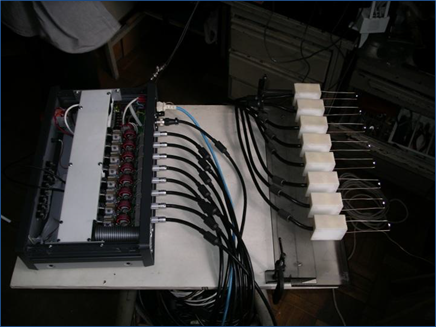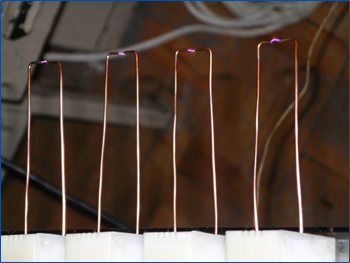Arc Generator
Eight-channel arc generator
Present experimental model of high-voltage radiofrequency(RF) generator is an original multichannel high frequency solid-state source of sinusoidal-like voltage composed of Main Unit and High Voltage Transformers. This device works in two main, automatically switching modes: fire, with high output voltage, proceeding up to breakdown of discharge gap and limit, during discharge burning, with limited output current/power.
| Main features:
Conversion frequency 0.8-1.2 MHz; Output voltage amplitude: up to 25 kV(fire mode); 200-2000 V(limit mode). Output power(limit mode, each channel) – 100-150 W, duty cycle up to 40%; Conversion efficiency(limit mode) – 0.7-0.9; Discharge gap – 1 - 5 mm(at atmospheric pressure, recommended); TTL/CMOS compatible control inputs. |
 |
Such generator can be successfully used in many applications, partially it is practically ready device to perform internal combustion engine ignition. As compared with regular ignition systems, this device does not include any energy storage like big enough inductance or capacitance due to it is ready to produce an arc/spark at any time. The discharge duration, which amounts to1-1.5 ms conventionally, is also practically unlimited, over the range from several microseconds to tens milliseconds, about 4 orders width. Eight independently controlled channels give the opportunity to serve up to 8-cylinder engine precisely.

Multichannel RF arc generator as gasoline engine igniter
Some time ago, in collaboration with the OSU, we investigated the effects of radiofrequency localized plasma (RF arc plasma) on the sub- and supersonic flows [1]. Similar plasma could be generated in the fuel mixture at pressures of 10-20 bars. The theoretical [2] and experimental [3] results demonstrate the advantages of fuel mixture ignition at high pressure using alternative ways for combustion initiation. As compared with regular spark ignition system, RF arc generator does not include energy storage like big enough inductance or capacitance due to it is ready to produce an arc/spark at any time. The discharge duration, which amounts to1-1.5 ms conventionally, is also practically unlimited, over the range from several microseconds to tens milliseconds, about 4 orders width. So, using RF arc generator as engine ignition exciter enabled to expect severe gains:
- Stable and powerful arc/spark generation, optimized for given conditions;
- Much higher plasma gas temperature;
- Electrode erosion decreasing;
- Improvement of fuel mixture firing/burning, so
- engine power enhancement;
- sharper engine response;
- exhaust gases composition modification;
- AC output waveform gives possibility to use another types of spark plug like DBD(Dielectric Barrier Discharge) constructions having more space-distributed plasma.
In conclusion we could propose to initiate teamwork with the object of study of multichannel RF arc generator as gasoline engine igniter.
References:
- J.-H. Kim, M. Nishihara, I. V. Adamovich, M. Samimy, S. V. Gorbatov, F. V. Pliavaka 'Development of localized arc filament RF plasma actuators for high-speed and high Reynolds number flow control' Exp Fluids (2010) 49:497–511, DOI 10.1007/s00348-010-0819-y;
- H Takana, I V Adamovich and H Nishiyama, Computational Simulation of Nanosecond Pulsed Discharge for Plasma Assisted Ignition, Journal of Physics: Conference Series 550 (2014) 012051 doi:10.1088/1742-6596/550/1/012051
- Zähringer, K., Pliavaka, K., Pliavaka. F., Gorbatov, S. and Thévenin, D.: Atmospheric generation of excited oxygen for combustion intensification by a RF plasma discharge. In: 6th European Combustion Meeting (ECM 2013), Lund, Sweden, P1-88/1-5, 2013.



